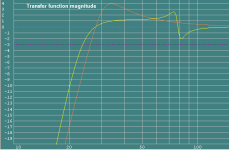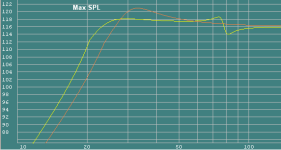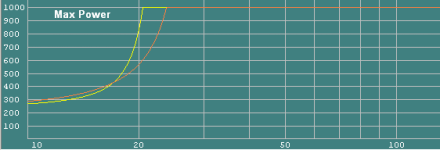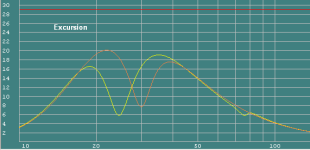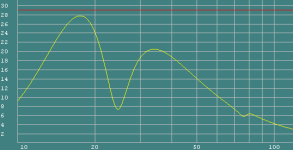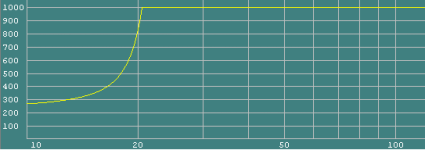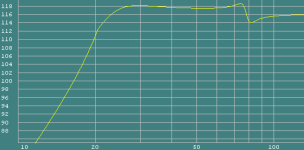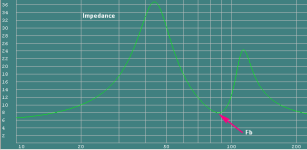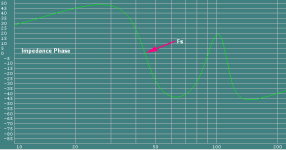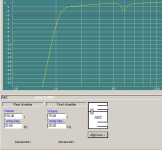I am currently working on a build and I'm looking for help on designing an enclosure. Could someone with experience comment on size and tuning for these or useable software.
does the tuning shelf extend from the lower tuning all the way to the upper tuning freq or does it peak in between?
also difference between 3:1 and 2:1 ratio?
optimal tuning for a 12w7
specs:
Free Air Resonance (Fs) 27.2 Hz
Electrical “Q” (Qes) 0.514
Mechanical “Q” (Qms) 7.807
Total Speaker “Q” (Qts) 0.482
Equivalent Compliance (Vas) 2.33 cu ft / 66.0 L
One-Way Linear Excursion (Xmax)* 1.15 in / 29 mm
Reference Efficiency (no) 0.249%
Efficiency (1 W / 1 m)** 86.2 dB SPL
Effective Piston Area (Sd) 84 sq in / 0.0542 sq m
DC Resistance (Re) 2.47 Ω
does the tuning shelf extend from the lower tuning all the way to the upper tuning freq or does it peak in between?
also difference between 3:1 and 2:1 ratio?
optimal tuning for a 12w7
specs:
Free Air Resonance (Fs) 27.2 Hz
Electrical “Q” (Qes) 0.514
Mechanical “Q” (Qms) 7.807
Total Speaker “Q” (Qts) 0.482
Equivalent Compliance (Vas) 2.33 cu ft / 66.0 L
One-Way Linear Excursion (Xmax)* 1.15 in / 29 mm
Reference Efficiency (no) 0.249%
Efficiency (1 W / 1 m)** 86.2 dB SPL
Effective Piston Area (Sd) 84 sq in / 0.0542 sq m
DC Resistance (Re) 2.47 Ω
Hi,
One source for FREE software that does ABC = WinISD v0.7.0.809
Yes
It depends on where the low & high tunings are placed, & the volume of both cavities, & the ratio of both to each other. Often there can be a dip in the middle.
See above
That depends on what you want from the design. For eg, Max Power, f3, SPL @ 1W, Max SPL, etc etc.
Let us know how you get on
One source for FREE software that does ABC = WinISD v0.7.0.809
does the tuning shelf extend from the lower tuning all the way to the upper tuning freq
Yes
or does it peak in between?
It depends on where the low & high tunings are placed, & the volume of both cavities, & the ratio of both to each other. Often there can be a dip in the middle.
also difference between 3:1 and 2:1 ratio?
See above
optimal tuning for a 12w7
That depends on what you want from the design. For eg, Max Power, f3, SPL @ 1W, Max SPL, etc etc.
Let us know how you get on
I want the cabinet to have a very flat response, will being a little bit more efficient than my current ported set up. A huge problem i'm currently having, and something I'm shooting for is excellent transient response, without using a sealed enclosure.
low tuning - 27 Hz
high tuning - 53? I think it's just under an octave, correct me if i'm wrong.
how fast will it roll off below 27? If my x-over is set at 20... would it be recommended to tune lower?
can you further explain the effects of a 2:1 or 3:1 ratio? I've only ever seen these two recommended but never why...
I have space for around 3.5 ft3, maybe more. (I'll be using two woofers, so read 7 ft3)
low tuning - 27 Hz
high tuning - 53? I think it's just under an octave, correct me if i'm wrong.
how fast will it roll off below 27? If my x-over is set at 20... would it be recommended to tune lower?
can you further explain the effects of a 2:1 or 3:1 ratio? I've only ever seen these two recommended but never why...
I have space for around 3.5 ft3, maybe more. (I'll be using two woofers, so read 7 ft3)
Have a look at these designs i've in done, with the software i recommended to you earlier.
The Reflex is Orange & the ABC is Yellow.
Reflex
Vol = 4.670 ft3 - fb = 30Hz
ABC
Vol = 3.178 ft3 = 1.589 ft3 = 4.767 ft3 - fb's = 15Hz + 40Hz
Both with a LR 24dB 20Hz HPF
Speakers are, mainly, limited by 2 things, Power & Excursion limits. One is usually reached before the other. So even though this driver lists Xmax as 29mm, it can Only take 1000W Max. So it has more excursion than it needs, before Max Power is reached. Which means you won't be able to take advantage of all of it !
I was going to strongly suggest you install the software, & experiment for yourself with various different options/designs etc. Post back with your results, hopefully with some screen shots "screenies"
Unfortunately i've just checked the DL link for you, & seen this
Very sad
The version of WinISD = v0.7.0.809 that does ABC's was only available via their forums. The other 2 versions still available on their home page, don't. If you like though, i can upload somewhere 7 PM you the DL link
The Reflex is Orange & the ABC is Yellow.
Reflex
Vol = 4.670 ft3 - fb = 30Hz
ABC
Vol = 3.178 ft3 = 1.589 ft3 = 4.767 ft3 - fb's = 15Hz + 40Hz
Both with a LR 24dB 20Hz HPF
Speakers are, mainly, limited by 2 things, Power & Excursion limits. One is usually reached before the other. So even though this driver lists Xmax as 29mm, it can Only take 1000W Max. So it has more excursion than it needs, before Max Power is reached. Which means you won't be able to take advantage of all of it !
I was going to strongly suggest you install the software, & experiment for yourself with various different options/designs etc. Post back with your results, hopefully with some screen shots "screenies"
Unfortunately i've just checked the DL link for you, & seen this
www.linearteam.org • Information We have taken down the forums because not being able to fight against extensive spam.
Very sad
The version of WinISD = v0.7.0.809 that does ABC's was only available via their forums. The other 2 versions still available on their home page, don't. If you like though, i can upload somewhere 7 PM you the DL link
Attachments
there's no way to utilize that x max then? I have seen these woofers fully exursioned (sp.?) and it looks intense...
JL only recomends 1.7 ft3... there's no way that could come even close to 29mm.
Question, If I were to remove the LP, and tune the enclosure so it approached xmax around 19-20 hertz, is there a real chance it will reproduce something below such as 15 hertz and bottom out? I listen to regular mp3's. rap, rock, radio...
An externally hosted image should be here but it was not working when we last tested it.
JL only recomends 1.7 ft3... there's no way that could come even close to 29mm.
Question, If I were to remove the LP, and tune the enclosure so it approached xmax around 19-20 hertz, is there a real chance it will reproduce something below such as 15 hertz and bottom out? I listen to regular mp3's. rap, rock, radio...
As the volume of the enclosure rises, so will cone excursion correct? resulting in more spl? In this case, could I create a cabinet that is 7.0 or 8.0 ft3 rather than previosly stated, and use an isobaric setup?
I would lose the 3db from the second speaker, however would I gain 3 db from the larger enclosure?
Does isobaric loading increase sq (transient response, lf response, etc..) ?
I would lose the 3db from the second speaker, however would I gain 3 db from the larger enclosure?
Does isobaric loading increase sq (transient response, lf response, etc..) ?
there's no way to utilize that x max then? I have seen these woofers fully exursioned (sp.?) and it looks intense...
Mental is how i would describe it
Question, If I were to remove the LP, and tune the enclosure so it approached xmax around 19-20 hertz, is there a real chance it will reproduce something below such as 15 hertz and bottom out? I listen to regular mp3's. rap, rock, radio...
You mean HP ? Yes you can remove it, but i wouldn't, instead if you can, have one that is at or just below your lowest tuning. For eg, if you tune it to 20Hz make the HP 20Hz - 15Hz. You're confusing tuning with Xmax. Just because a box is tuned low, does not mean it will atomatically reproduce down there, if there are no such frequencies in the material being played. Also even if there are, if the boxes low frequency is tuned too low for the driver, the response will be tailing off by then, sometimes by quite a bit !
was the reflex a standard ported enclosure? Because I was looking into doing a triple chamber double reflex.. that or the ABC. My only concern is transient response. I want clean tight bass, and then I want it to be loud
Yes it was, because you stated "My current setup is 1.67 cu ft ported at 31 Hz." I did that for you so you could compare what you have now, with what you initially posted wanting, an ABC with that driver.
Here's the ABC @ 1000W tuned to 15Hz & a 15Hz LR 24dB HPF. It's run out of power @ 20.5Hz & Xmax is near Maximum now.
As the volume of the enclosure rises, so will cone excursion correct? resulting in more spl?
No, the excursion will be less, & the box will be able to be tuned lower, so it will be able to produce lower frequencies better. The SPL could actually be less !
If you want to discuss other options, such as isobaric etc, you should start a new thread/s.
@ tb46
Hi, pleasure, it's nice to be appreciated
Search for "facebook privacy guide" just one for eg, The Always Up-to-Date Guide to Managing Your Facebook Privacy You won't regret it, Regards
Attachments
Last edited:
Southern Ontario - Canada. an hour away from Toronto.
"if the boxes low frequency is tuned too low for the driver, the response will be tailing off by then, sometimes by quite a bit !"
could you explain the relation between fs and box tuning? some say a port negates the fs and some say differently.
for an fs of 27 hertz what are some tuning variables and their effects
"if the boxes low frequency is tuned too low for the driver, the response will be tailing off by then, sometimes by quite a bit !"
could you explain the relation between fs and box tuning? some say a port negates the fs and some say differently.
for an fs of 27 hertz what are some tuning variables and their effects
When i asked "Where are you ?" I was wondering why you hadn't replied & commented on my post ? I spent a lot of time on WinISD for you, & composing/posting the various posts & taking screenies & uploading them etc etc. 
"if the boxes low frequency is tuned too low for the driver, the response will be tailing off by then, sometimes by quite a bit !"
Driver Fs data sheet spec is out of a box, unloaded. Once you put it in ANY box, the Fs usually rises, sometimes quite a bit. Unless the box is Massive, but then the effeciency would be Very low. The port/s in combination with the box volume/s, tune the box to a specific Fb. See my screenies
It depends on the box size/tuning, & port/s size/s, see above. Port noise can be a problem, if undersized.
"if the boxes low frequency is tuned too low for the driver, the response will be tailing off by then, sometimes by quite a bit !"
could you explain the relation between fs and box tuning? some say a port negates the fs and some say differently.
Driver Fs data sheet spec is out of a box, unloaded. Once you put it in ANY box, the Fs usually rises, sometimes quite a bit. Unless the box is Massive, but then the effeciency would be Very low. The port/s in combination with the box volume/s, tune the box to a specific Fb. See my screenies
for an fs of 27 hertz what are some tuning variables and their effects
It depends on the box size/tuning, & port/s size/s, see above. Port noise can be a problem, if undersized.
Attachments
@ deebeez92
We all were once
Pleasure
Keep practising with WinISD, by changing the Fb & Volume. One at a time, then both together. You'll soon see what a difference it/they make. And check the Excursion too
Distortion rises with more & more power, and/or increasing Xmax.
.ohh haha wow I'm a newb
We all were once
@ Zero D That time spent is much appreciated Thank you
Pleasure
i'm still trying to wrap my head around Fs and Fb in relation to tuning and impedence rises, and distortion.
Keep practising with WinISD, by changing the Fb & Volume. One at a time, then both together. You'll soon see what a difference it/they make. And check the Excursion too
Distortion rises with more & more power, and/or increasing Xmax.
@ Zero D
I found the winisd version you were talking about, and I've been testing different enclosures. My question is this:
This website is generally accepted as the go to for designing these enclosures. It dictates that the entire enclosure is the volume of which the first port should be tuned to. This volume is then divided into 2/3 and each chamber is ported with the same size port as the first.
The Subwoofer DIY Page - Dual-chamber ported systems
Winisd's design of the ABC enclosure is different.
It designs the enclosure so that the first chamber's tuning frequency is only relative the first chamber's volume. It doesn't and cannot include the second chamber's volume in the first tuning frequency.
The first chamber and it's tuning frequency only correspond to the first chamber's volume (not the entire enclosure as a whole).
In the second example, the second tuning frequency can be changed...
These options change the entire function of the enclosure. In the first, the two outer ports will resonate together in the entire volume of the enclosure to produce a tuning of say 26 hertz.
My thinking is that the website says i'm supposed to tune "the entire enclosure" to 26 herz,
and Win ISD says i'm supposed to tune "just the first chamber" to 26 hertz.
If i tune the second chamber to 26 hertz, then the port sizes are not the same. If i tune the second chamber an octave above, like it theoretically would be in the first example, and I make the intrachamber port the same length as well...
what happens to the first tuning frequency when it plays 26 hertz? because the volume of the enclosure would now be a full third larger, changing the tuning frequency.
AHHHH
can someone please help me with my dilemna?
I found the winisd version you were talking about, and I've been testing different enclosures. My question is this:
This website is generally accepted as the go to for designing these enclosures. It dictates that the entire enclosure is the volume of which the first port should be tuned to. This volume is then divided into 2/3 and each chamber is ported with the same size port as the first.
The Subwoofer DIY Page - Dual-chamber ported systems
Winisd's design of the ABC enclosure is different.
It designs the enclosure so that the first chamber's tuning frequency is only relative the first chamber's volume. It doesn't and cannot include the second chamber's volume in the first tuning frequency.
The first chamber and it's tuning frequency only correspond to the first chamber's volume (not the entire enclosure as a whole).
In the second example, the second tuning frequency can be changed...
These options change the entire function of the enclosure. In the first, the two outer ports will resonate together in the entire volume of the enclosure to produce a tuning of say 26 hertz.
My thinking is that the website says i'm supposed to tune "the entire enclosure" to 26 herz,
and Win ISD says i'm supposed to tune "just the first chamber" to 26 hertz.
If i tune the second chamber to 26 hertz, then the port sizes are not the same. If i tune the second chamber an octave above, like it theoretically would be in the first example, and I make the intrachamber port the same length as well...
what happens to the first tuning frequency when it plays 26 hertz? because the volume of the enclosure would now be a full third larger, changing the tuning frequency.
AHHHH
can someone please help me with my dilemna?
@ deebeez92
Better late than never
Good
Re - questionS
What you need to remember is, there is more than one fixed way to do things.
The designs that show one chamber twice the volume of the other chamber, are correct. But, they don't have to be that ratio, they can be whatever suits your purpose. Keeping the ratios 2 - 1 enables you to also keep the ports equal in size. Don't forget that WinISD v0.7.0.809 is BETA software, & although it works just fine, as yet the intra-chamber Port is only Auto scaled for a 2 - 1 ratio. If you deviate from this, you have to work out the size yourself.
Have another good look at the excellent The Subwoofer DIY Page - Dual-chamber ported systems It explains in depth how to calculate for deviations etc, amongst Lots of other useful info etc.
Plus, you don't have to tune both chambers an octave or so apart. In ALL the designs i've seen, they have been ! See my screenie that shows a design of mine that bucks that trend I've done it to further show what can be achieved by experimenting.
Get experimenting
I found the winisd version you were talking about,
Better late than never
and I've been testing different enclosures.
Good
Re - questionS
What you need to remember is, there is more than one fixed way to do things.
The designs that show one chamber twice the volume of the other chamber, are correct. But, they don't have to be that ratio, they can be whatever suits your purpose. Keeping the ratios 2 - 1 enables you to also keep the ports equal in size. Don't forget that WinISD v0.7.0.809 is BETA software, & although it works just fine, as yet the intra-chamber Port is only Auto scaled for a 2 - 1 ratio. If you deviate from this, you have to work out the size yourself.
Have another good look at the excellent The Subwoofer DIY Page - Dual-chamber ported systems It explains in depth how to calculate for deviations etc, amongst Lots of other useful info etc.
Plus, you don't have to tune both chambers an octave or so apart. In ALL the designs i've seen, they have been ! See my screenie that shows a design of mine that bucks that trend I've done it to further show what can be achieved by experimenting.
Get experimenting
Attachments
The Subwoofer DIY Page - Dual-chamber ported systems
Actually, as I read it, the page is incorrect. You have stated the correct analysis.
You say: Tune the whole enclosure using a (single) port. Then subdivide the encosure and add two more ports of the same size, one for the second chamber and one between them.
The page says: Tune the whole enclosure using two ports, each half the area of a single port. Then subdivide the enclosure and put one of the ports in each chamber, and a third port of the same size between them.
The page's method results in the tuning being way out.
...This website is generally accepted as the go to for designing these enclosures. It dictates that the entire enclosure is the volume of which the first port should be tuned to. This volume is then divided into 2/3 and each chamber is ported with the same size port as the first. ...
Actually, as I read it, the page is incorrect. You have stated the correct analysis.
You say: Tune the whole enclosure using a (single) port. Then subdivide the encosure and add two more ports of the same size, one for the second chamber and one between them.
The page says: Tune the whole enclosure using two ports, each half the area of a single port. Then subdivide the enclosure and put one of the ports in each chamber, and a third port of the same size between them.
The page's method results in the tuning being way out.
- Status
- This old topic is closed. If you want to reopen this topic, contact a moderator using the "Report Post" button.
- Home
- Loudspeakers
- Subwoofers
- ABC enclosure
